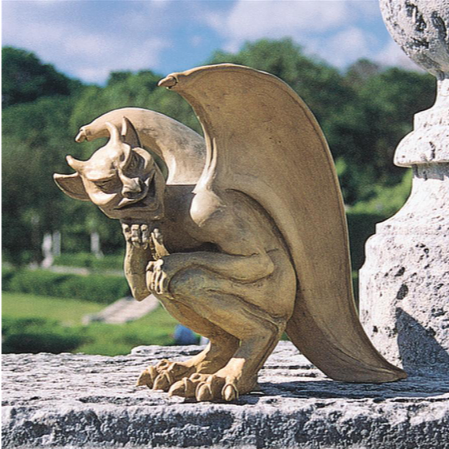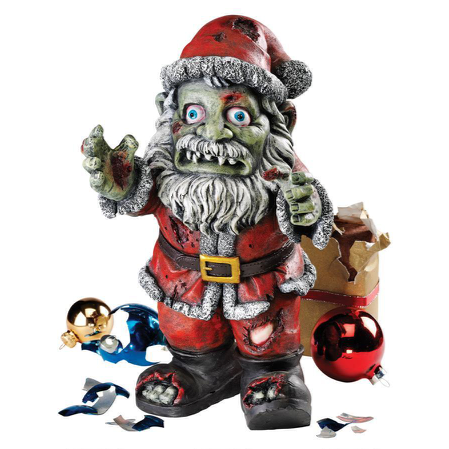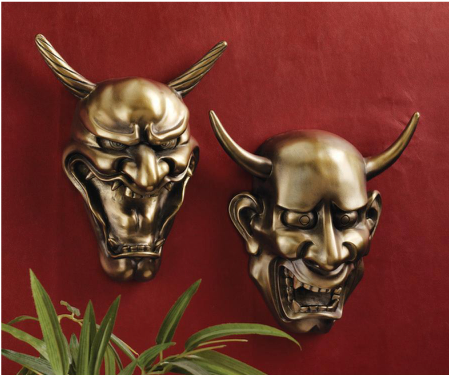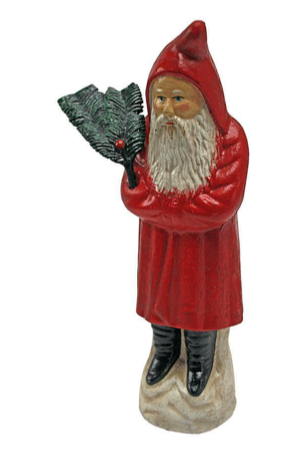“Then he got an idea, a wonderful awful idea.”
– Referring to the Grinch in How the Grinch Stole Christmas Book by Dr. Seuss, 1957
Last week on the Design Toscano Blog we discovered the long history of Santa Claus so it’s only fitting we move on to the original anti-Santa, Krampus. The Christmas season would not be the same without Krampus, also known as the Grinch. He may seem to stand for things that are not very Christmassy, but the Grinch originates from an extensive tradition of “anti-Santas” that have a long history in Europe. Some of them have even traveled along with St. Nicholas to scare the naughty children into being good.
KRAMPUS ORIGINS IN EUROPE

In centuries past, Germans and Scandinavians celebrated the Feast of Saint Nicholas (Sankt Nikolaus) observing his day on December 6th, along with most Eastern Christian countries, as the kindly saint rewarded good children with fruit, nuts and sweets. The legend says Krampus, a horrific beast—half-goat, half-demon—was created as a counterpart to St. Nicholas. Krampus appeared as a dark-haired devil with pointed horns, fangs and a long tongue, who wore chains and bells and carried a bundle of switches to swat the naughty children, or put them in his sack and took them away to his lair. Yikes!
Krampus appeared in the streets of parts of Germany and Austria where the children came to dread the appearance of the beast. Other regions of Germany and Austria feared Belsnickle, Knecht or Ruprecht, all of whom were also represented by black bearded men who carried switches to scare or beat naughty children.
There are many old Christmas traditions of helpers for the saint that can still be found in various countries, acting as foils for the benevolent Saint Nicholas. France has Hans Trapp, another anti-Santa, whose spirit at Christmas would come back and abduct children, and Pere Fouettard, who also accompanies St. Nicholas on his rounds dispensing lumps of coal or beatings on children who misbehave.
The Netherlands and Belgium have Zwarte Piet, or Black Peter, who travels with St. Nicholas listening at chimneys to evaluate the good or bad behavior of the humans inside. Nowadays Black Peter is highly controversial as he is traditionally depicted as a moor from Spain wearing blackface.
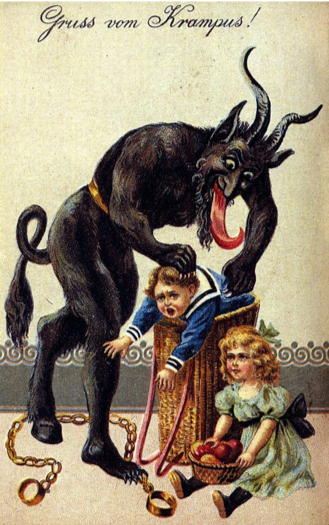
GRINCHY FACT: Krampus is derived from the German word krampen, meaning claw.
Krampus Night or Krampusnacht is celebrated on the evening of December 5th when children would leave out their boots or shoes checking them the next day to see if they were filled with treats and toys, or wood and coal.
A modern and more adult tradition now practiced in Austria, Germany, Hungary, Slovenia, and the Czech Republic consists of drunken men dressing as devils who take over the neighborhood for a Krampus Run where they chase people through the streets.
MODERN DAY KRAMPUS IMMIGRATES TO THE US
Here in the U.S. Krampus has been having a resurgence as people are searching for ways to celebrate the holiday season in nontraditional ways. Two books of German and Austrian Krampus postcards from the 19th and 20th centuries were published in 2004 and 2010 by a collector and graphic designer, Monte Beauchamp. He then began curating shows of his Krampus postcards, with slogans like “Greetings from Krampus,” around the country. A friend of Beauchamp’s organized a Krampus club in L.A. and since then there have been Krampus movies, Krampus has been mentioned in an episode of the show Supernatural and starred in Anthony Bourdain’s animated A Krampus Carol. Krampus is becoming well-known as he has been immortalized in US comics, stories, films, parades, and bar crawls. Krampus parties are being thrown, and many Americans attend Krampusnachts and participate in Krampus themed fun runs.
Recently, Austria is attempting to change the harsh persona of Krampus by selling Krampus collectables such as horns, figures and even chocolates.
“Be it ever so heinous, there’s no place like home.”
– Jim Carrey as the Grinch from How the Grinch Stole Christmas Movie, 2000
LET KRAMPUS LIVEN UP YOUR HOLIDAYS
If you like the off-beat or are fond of something different, unusual and maybe a bit crazy, check out Design Toscano’s offering of rare, strange and outrageous creatures that remind you of Krampus and will help celebrate the holidays in unique style!
Another mysterious hopping creature that we found is immortalized by artist Richard Warsin, as The Legend of the Cambridge Hopping Gargoyle Statue (OS68829) which leaves gargoyle-like tracks behind him. A rare find, this Design Toscano-exclusive mischievous creature is prevalent in folklore, and hand painted in antique gothic stone shades, as he crouches ready to pounce. With a sly expression, bat wings, fiery eyes, and a devilish tongue our Cambridge Hopping Gargoyle sculpture will make himself at home all year round; one of our customers even decorated him with a Santa hat for the holidays!
Artist Monte M. Moore expertly created The Skull of the Horned Beast Sculpture (CL3028) with curved horns, spiked canines, and a wicked forked tongue as a guiding force from mythology. Exclusive to Design Toscano, hand painted in gothic shades, this very detailed devilish Skull of the Horned Beast will enhance any skull collection. Watch out for the horned beast and the creature that goes bump in the night.
If you are looking for the most unusual holiday decoration ever, there’s no need to look any further! This unique Design Toscano-exclusive Zombie Claus Holiday Statue (CL6691) will stand out in any crowd of holiday decorations. This jolly old brain eater will shuffle his way into your holiday collection. With his ragged red Santa suit and cap, staring eyes and green skin, Zombie Claus will add a dash of Christmas color, creating an exceptional addition to any zombie or holiday display.
Get “ahead” of the usual holiday decorating with this astounding Skelly Claus II Holiday Skeleton Ornament (QS23709). Unique and exclusive to Design Toscano, this hand painted Gothic jolly old Skelly Claus is ready to celebrate the season! Hand painted in faux bone with a sparkly Santa hat, he will delight skull collectors while helping getting them get in a holiday mood.
This pair of Hannya Demon Mask Wall Sculptures (CL96298) are created in the Japanese style of masks used in the Noh Theater. A tradition since 1558, these audacious and beautiful scaled demon masks with faux antiqued gold finish are exclusive to Design Toscano. The Noh mask has a wide open mouth and the Kagura mask has a huge mouth filled with fangs, both feature pointy horns and penetrating eyes. Sent to cause chaos, these demons will look even more mystical on your wall.
Hanging from the wall or resting on a tabletop, this weird eerie Design Toscano exclusive Creepy Thing can haunt you or freak out your friends whether displayed in the shadows or in broad daylight. We are not sure where it came from but The Creepy Thing Wall Sculpture (CL6210) is sculpted in three dimensions, then hand painted in such detail, with its wrinkly skin, knobby claws and dark beady eyes, it will jump out at you!
Our Gothic Reaping Solace: The Creeper Sitting Statue (JQ8855) is very popular in European countries where this shadowy Creeper causes many to take a second look at how they live their life. Beguiling and moody, this Design Toscano exclusive was skillfully sculpted for us by artist Liam Manchester. Perched on a shelf, windowsill or bookcase you can almost feel the power of this matte black, Medieval sitting Creeper that was sent to deliver his message.
GRINCHY FACT: Some people think Krampus might be losing his edge because of his new found popularity.
FOR THOSE WITH TAMER TASTES, TRY THIS SPIN ON KRAMPUS
In Scandinavia the Yule Goat is an important symbol, and is commonly seen in and around houses and villages during the Christmas season. This tradition of displaying the Yule Goat originates from the belief that Thor’s, the god of thunder, chariot was drawn by two goats. In the 17th century, young men dressed up as goats and demanded gifts or they would create mischief. In the 19th century, people gave gifts of straw goats as Christmas decorations, and today there are as many different Yule goats as we have different reindeer. You’ll even find Yule Goats dressed as Santa.
Design Toscano exclusively offers many goats including this cute little Billy Goat Statue (NE100044) that is perfect to represent the Yule Goat. So realistically hand painted in cream and browns, Billy stands thirty-one inches high, representing one of the oldest domesticated farm animals. Of course there’s always the “goats” of Christmas’ past, but that’s another story.
No, it’s not the man in the moon, but Old Saint Nick Holiday Stained Glass Window (TF28024) that just happens to be a sparkling work of art glass that is moon shaped. With a droll little mouth, bright green holly-decked red Santa hat and long white beard made from 60 hand cut pieces of authentic stained glass, this Christmas window decoration will be a sparkling standout while the sun shines, and if surrounded by a string of fairy lights, it will glitter merrily at night too. This Santa Claus makes a wonderful holiday gift to yourself or a hostess.
“Christmas already? Ugh!”
–The Grinch from How the Grinch Stole Christmas
Add this German Santa Antique Replica Die Cast Iron Still Action Coin Bank (SP1073) to any shelf or holiday display, surround it by fresh greens, sprigs of silk holly and berries, or a few tea lights to create a nostalgic Christmas display. This Design Toscano classic, quality foundry cast iron Saint Nicholas was cast from an 1890 mold. Krampus’ companion, this red-hooded German Santa is a heavyweight antique replica that’s appealing as a picture postcard.
You better watch out for Krampus and the other hundreds of creepy creatures that Design Toscano offers for all interests.
As the Krampus warns, Brav Sein, “Be Good!”
Posted by Sue Mell


